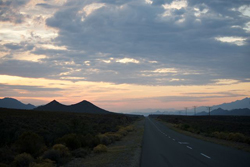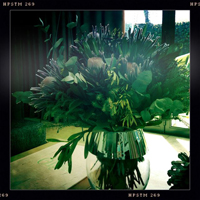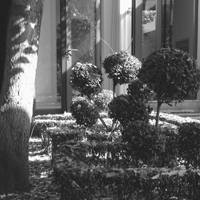Peaceful
26/04/12 17:48

Many people imagine Africa influenced by the movies they see on television and in the cinemas. But is this really like the bush is?
All films are a compilation of moments in the bush. The choice of moments is influenced by the target group the film production has in mind.
The traditional BBC documentary with David Attenborough was aiming on education, the wonder of nature and to give the audience the feeling to be there. Nowadays wildlife TV channels focus on entertaining a target group that likes action, spectacular situations, high tech and excitement. On the other hand Disney has just discovered a market for nature fairy tales with real animals where the lion’s mouth gets cleaned from blood after filming and the kill happens out of sight.
It is not surprising that people have diverse ideas what to expect when visiting the bush for the first time. Often female visitors are afraid of seeing fighting and kills all the time and male visitors are disappointed when not seeing spectacular kills the whole day. But mostly all end up loving it. A day in the bush is for 95 % peaceful and the other five percent can be impressive moments with their own beauty. There is nothing like a one-hour sequence of kills and fights in the bush. Only men create something like that.
Ute Sonnenberg, rohoyachui.com
Silence and Space
25/04/12 18:43

There is a semi-desert in South Africa, called the Karoo, where one can easily think that there is nothing but dry land and heat. The heat is what I’m struggling with when going to deserts, the heavy heat, almost paralyzing, just trying to keep breathing and then I wonder why I came to this place. I’m always arguing with myself when I’m there, impatiently waiting to leave this oven. But the moment I left I feel homesick to this desert and I feel the impact its beauty made. And I look at the images and see silence and space, a strong remedy what makes one falling in love with it.
Probably the best ever Müsli … served in the bush
24/04/12 11:56

There is almost nobody not asking for the recipe when staying at Londolozi. So, to make it easy, here the recipe for probably the best müsli ever!
Ingredients:
Glaze:
500& Butter
500ml Vegetable oil
5OOml Brown sugar
500ml Golden syrup
250ml Good honey
Cereal:
1kg Jungle Oats
750£ All Bran flakes
7508 Fiber Bran
500g Puffed Wheat
500ml Wheat germ
5OOml Sunflower seeds
500m1 Sesame seeds
500ml Shredded coconut
1kg Mixed nuts
Method:
Combine: all the ingredients forth' glaze in a medium size saucepan and heat slowly,stirring to make sure the sugar dissolves, bring to a short boil and set aside.
Combine all the cereal in a bowl and pour on the syrup. mix well and spread mixture over several baking dishes, place in oven at 100’C. toast muesli until golden, remove from oven and let cool. Alternatively, for a better crunch, leave in oven overnight at lowest setting (try and see- all ovens are different, but toasting does lake
some time)
Happy Cooking!
With Love from Londoloz! Kitchen
Ute Sonnenberg, rohoyachui.com
Snap & Share
23/04/12 16:45



photo 1: Instagram, photo 2: Hipstamatic, photo 3: 645 PRO
Review on Instagram, Hipstamatic and 645 PRO.
Instagram is a fast and easy tool to snap and share and its for free. The interface is easy and practical, no submenus before taking the photo and only one step further to share. Open the app, take the picture, choose a filter (or not), check “ok” and the submenu to share opens. With three taps you decide what and where to share and its done. Not much thinking needed and lots of space for artistic playing. Just as easy as it is to handle, is also the result pretty. The filters create great retro looks and the results are often surprisingly interesting to share and keep.
Hipstamatic is also a free app, but in order to use the whole variety of the app you got to buy additional packages. This app requires more think-work. Hipstamatic allows the user to make combinations of different film types, flash types and lens types, all tools from the analog photography times. In order to do that, the user got do go through several submenus to choose the film, the lens and the flash. They can all be combined with each other, which give lots of possible combinations and possible results. There is a button for favorites, to save your favorite combination of film, flash and lens in order to find it easy the next time you want to use it. Helpful with the decision of “which combination” to use are the packages the films, lenses and flashes are sold in. They give a recommendation about what works best together and makes the choice a bit easier. Probably one gets faster when finding it’s way around in the app and having found the favorites, but then it’s probably a pity having bought also the other options. Sharing is easy. Just a tap and several options can be chosen. From my experience, sharing with Flickr didn’t work well.
645 PRO might sound complicated and demanding, but it is actually very easy and great to use and play. The interface is clear, no submenus to go through and the manual accessible with one “tap and hold”. Different ratios and films can be chosen easily and “live view” shows you what you are doing. If you prefer a normal “view finder” look, also this is possible. It works incredibly good and even night shots have a good quality. I had the impression that it works easier and better than my point and shoot camera. And just as easy is the sharing, tap and share.
Ute Sonnenberg, rohoyachui.com
Traveling with Photo Apps
21/04/12 13:10

Imagine you are on safari and photographing the leopard with Instagram, sharing it immediately on Facebook and Twitter with a nice retro filter. Great? I think so. The phone is not fast and suitable enough to manage wildlife photography in general, but when they sit still and you are anyway waiting at the sighting that they do something, this is just great.
All these incredible apps are so much fun, making it easy to snap away and add some artistic touch to it … and maybe sometimes covering that the photo wasn’t that good and the object neither … while sharing it with your social network. This makes learning the artistic side of photography an exciting experience and lots of fun and we usually learn easier when it is fun.
For those who want to practice the usual camera settings there is 645 Pro for iPhoone, that lets you set exposure, ISO and all other features of your usual camera. Well that becomes technical again and is not an easy snap away app, but can be nice to carry on practicing the technical side of photography as well.
Enjoy playing and sharing!
Here some apps to play with:
Hipstamatic http://hipstamatic.com/the_app.html
Instagram http://instagr.am/
645 Pro http://jag.gr/645/
Ute Sonnenberg, rohoyachui.com
Health on Safari & elsewhere
19/04/12 18:04

First of all talk to your GP for medical advice when traveling to Africa. He/she wills advice regarding vaccinations and malaria precautions. From there it is your own decision what steps you wish to take for your holiday in Africa.
I get often asked about the medical precautions necessary when traveling to Africa and especially about malaria. I’m not a doctor and always recommend talking to the GP. Secondly I share my own experiences if asked for. I will share in this blog my personal experience with malaria precaution and my personal choice of treatment. Please be aware, this is my personal experience and opinion and it suits my personal situation and physical condition. This doesn’t apply necessarily to others. Everybody needs to check which is appropriate for the own personal situation and physical condition.
On my first visit to Africa I used Malerone as malaria precaution, a product that most of the people get when going on safari. I was careful using it with the meals and experienced no side effects during the recommended period of use. Only afterwards back in Europe I noticed that a flue was stronger than usual, but didn’t pay much attention to it. During my second safari I used again Malerone. Back in Europe I suddenly got the chicken pocks. I had always been immune for the chicken pocks, what was proved by many exposures to school friends, who had the children’s decease. I never got it, but I got it after my safari. The friend I was traveling with had the virus picked up from a relative at home before the trip and I got it from her during the holiday. This was the second time I got sick in a way I usually never got sick and I wondered about the reason. The connection seemed to be the malaria precaution. I got to the conclusion that the tablets weakened my immune system what made me vulnerable for the viruses. From that moment I never took the pills again, although I had been since them very often in the bush and it became my work being in the bush.
I learned from people in the Masai Mara to use neem tea as precaution for all sorts of things including malaria and it works very well. From infections, stomach bugs, flues and maybe even things I wasn’t aware of it helped. Neem tea works very well for me and I can recommend to use it also when not being on safari, but please consult your doctor to make sure it is not interfering with any other medication or condition.
There are plenty of websites about the benefits of neem, here one example: “neem tea products”
Stay healthy and enjoy your traveling.
Ute Sonnenberg, rohoyachui.com
On the Edge of Africa
14/04/12 18:31

It is like a magnetic point and when I was there I had the feeling like falling off the continent any moment, as it is pulling one further into the ocean. I’m talking about the southern most point of Africa, Cape Agulhus.
It is that overwhelming feeling of standing on the edge of this huge continent and the tip is so tiny, like it is holding the whole continent from falling into the sea. I was emotional and don’t know quite why.
Being the southern most point of Africa means as much as land stops here, but it actually doesn’t. It goes further underneath the water where the Indian and Atlantic Ocean meet. If we could make us heavier and able to breath under water we could just carry on walking from the edge of Africa down the hill until we reach a valley and climb a hill again. I felt like standing on the top of a mountain experiencing fear of height by thinking that there is so much under the water and I recognized the feeling. I had it also with diving, as I could fall down, like from a high building, what I would do, if there wouldn’t be water.
All this came up when standing on the edge of Africa, realizing that there isn’t an edge of Africa, that Africa goes further under the ocean and it is never ending. All continents are connected, only the lakes got a bit big, that we can’t see the other side of the valley anymore. We are only standing on higher ground looking down into the depth of the water covered valley and in my case becoming emotional, hit by philosophical thoughts.
